Hotel Marketing in Australia: Contemporary Strategies Report
VerifiedAdded on 2020/05/04
|11
|1867
|422
Report
AI Summary
This report delves into the contemporary hotel industry, analyzing marketing strategies with a focus on the Australian market and family travelers. It begins with an introduction outlining the objectives, which include examining customer types and developing suitable marketing strategies. A literature review provides a situational analysis, considering political, economic, social, technological, legal, and environmental factors impacting the industry. The methodology includes both secondary and primary analysis, with a survey conducted among urban Australian families. Findings from the survey reveal customer preferences, such as the frequency of hotel bookings and expectations for additional services like discounts and hygiene maintenance. The results and discussion section connects these findings with the literature review, highlighting the importance of adapting to evolving customer needs. The report concludes by emphasizing the dynamic nature of the hotel industry and the need for organizations to refine their services to meet the expectations of valuable stakeholders, particularly urban families.
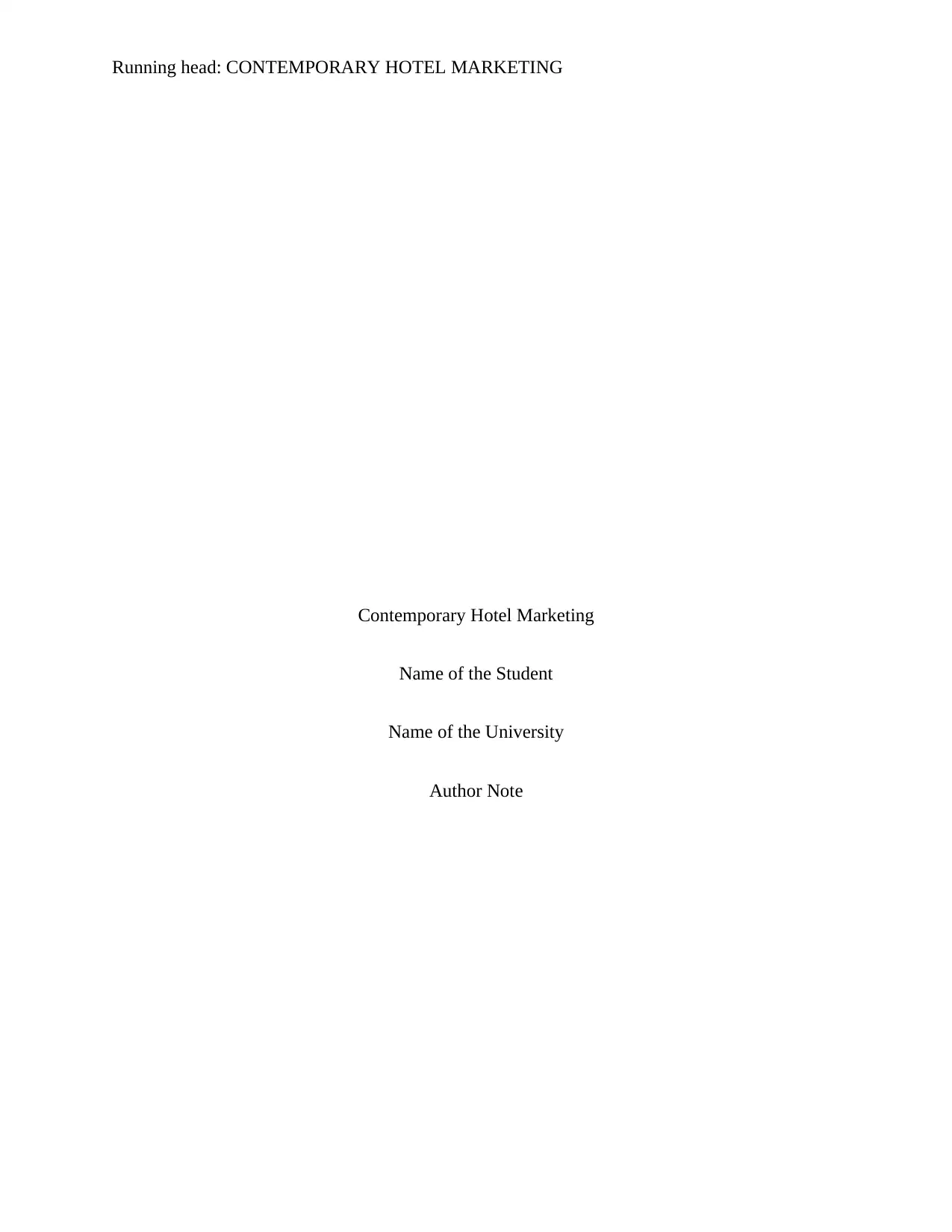
Running head: CONTEMPORARY HOTEL MARKETING
Contemporary Hotel Marketing
Name of the Student
Name of the University
Author Note
Contemporary Hotel Marketing
Name of the Student
Name of the University
Author Note
Paraphrase This Document
Need a fresh take? Get an instant paraphrase of this document with our AI Paraphraser
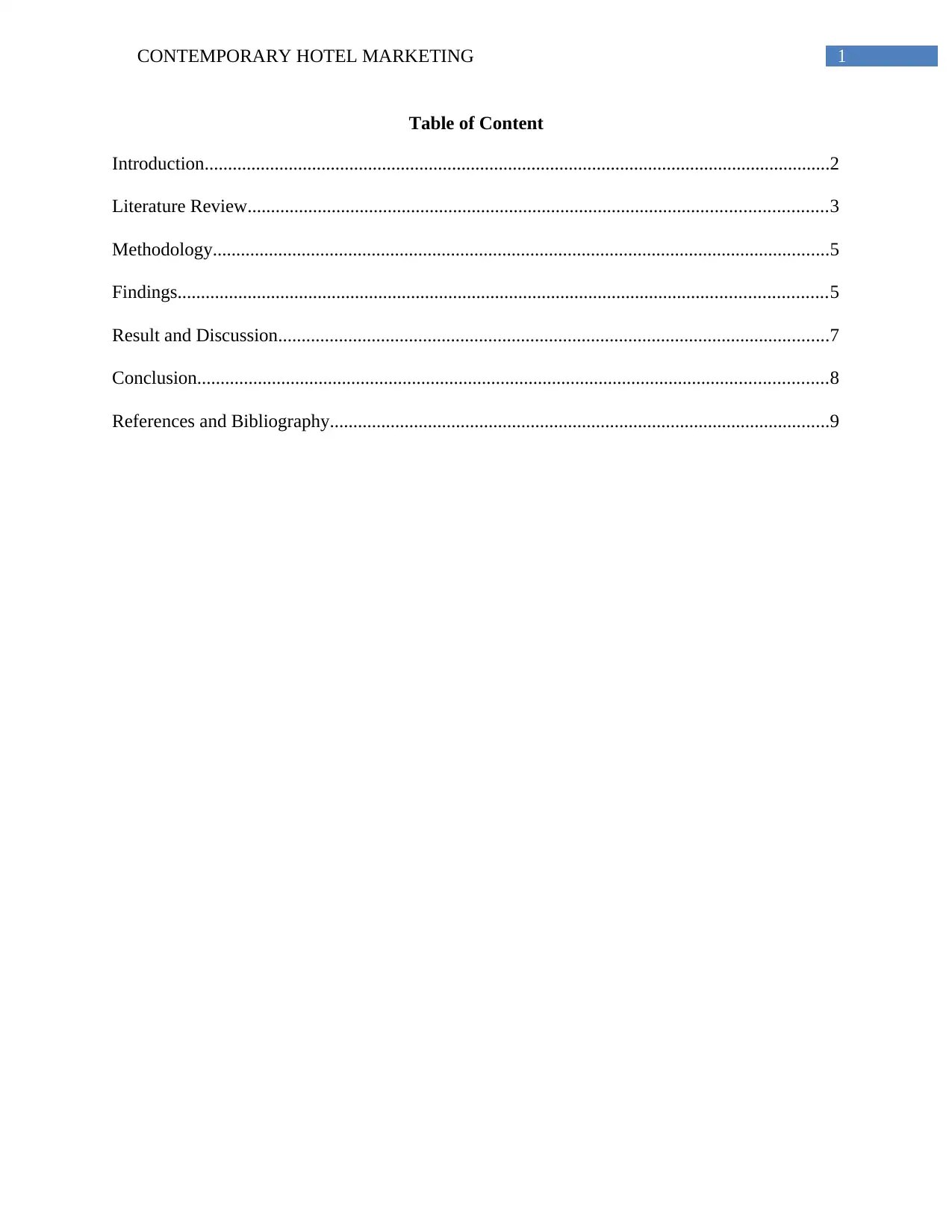
1CONTEMPORARY HOTEL MARKETING
Table of Content
Introduction......................................................................................................................................2
Literature Review............................................................................................................................3
Methodology....................................................................................................................................5
Findings...........................................................................................................................................5
Result and Discussion......................................................................................................................7
Conclusion.......................................................................................................................................8
References and Bibliography...........................................................................................................9
Table of Content
Introduction......................................................................................................................................2
Literature Review............................................................................................................................3
Methodology....................................................................................................................................5
Findings...........................................................................................................................................5
Result and Discussion......................................................................................................................7
Conclusion.......................................................................................................................................8
References and Bibliography...........................................................................................................9
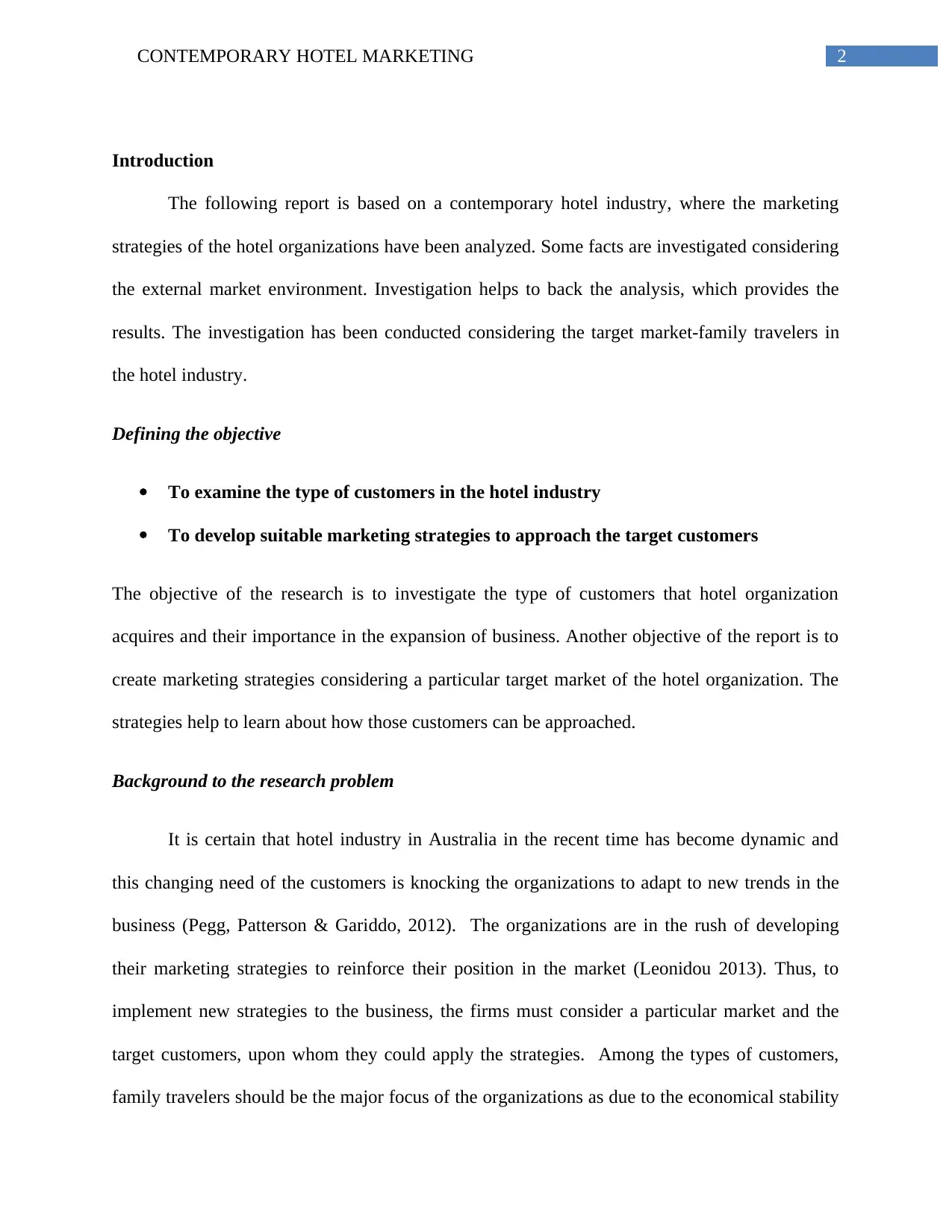
2CONTEMPORARY HOTEL MARKETING
Introduction
The following report is based on a contemporary hotel industry, where the marketing
strategies of the hotel organizations have been analyzed. Some facts are investigated considering
the external market environment. Investigation helps to back the analysis, which provides the
results. The investigation has been conducted considering the target market-family travelers in
the hotel industry.
Defining the objective
To examine the type of customers in the hotel industry
To develop suitable marketing strategies to approach the target customers
The objective of the research is to investigate the type of customers that hotel organization
acquires and their importance in the expansion of business. Another objective of the report is to
create marketing strategies considering a particular target market of the hotel organization. The
strategies help to learn about how those customers can be approached.
Background to the research problem
It is certain that hotel industry in Australia in the recent time has become dynamic and
this changing need of the customers is knocking the organizations to adapt to new trends in the
business (Pegg, Patterson & Gariddo, 2012). The organizations are in the rush of developing
their marketing strategies to reinforce their position in the market (Leonidou 2013). Thus, to
implement new strategies to the business, the firms must consider a particular market and the
target customers, upon whom they could apply the strategies. Among the types of customers,
family travelers should be the major focus of the organizations as due to the economical stability
Introduction
The following report is based on a contemporary hotel industry, where the marketing
strategies of the hotel organizations have been analyzed. Some facts are investigated considering
the external market environment. Investigation helps to back the analysis, which provides the
results. The investigation has been conducted considering the target market-family travelers in
the hotel industry.
Defining the objective
To examine the type of customers in the hotel industry
To develop suitable marketing strategies to approach the target customers
The objective of the research is to investigate the type of customers that hotel organization
acquires and their importance in the expansion of business. Another objective of the report is to
create marketing strategies considering a particular target market of the hotel organization. The
strategies help to learn about how those customers can be approached.
Background to the research problem
It is certain that hotel industry in Australia in the recent time has become dynamic and
this changing need of the customers is knocking the organizations to adapt to new trends in the
business (Pegg, Patterson & Gariddo, 2012). The organizations are in the rush of developing
their marketing strategies to reinforce their position in the market (Leonidou 2013). Thus, to
implement new strategies to the business, the firms must consider a particular market and the
target customers, upon whom they could apply the strategies. Among the types of customers,
family travelers should be the major focus of the organizations as due to the economical stability
⊘ This is a preview!⊘
Do you want full access?
Subscribe today to unlock all pages.

Trusted by 1+ million students worldwide
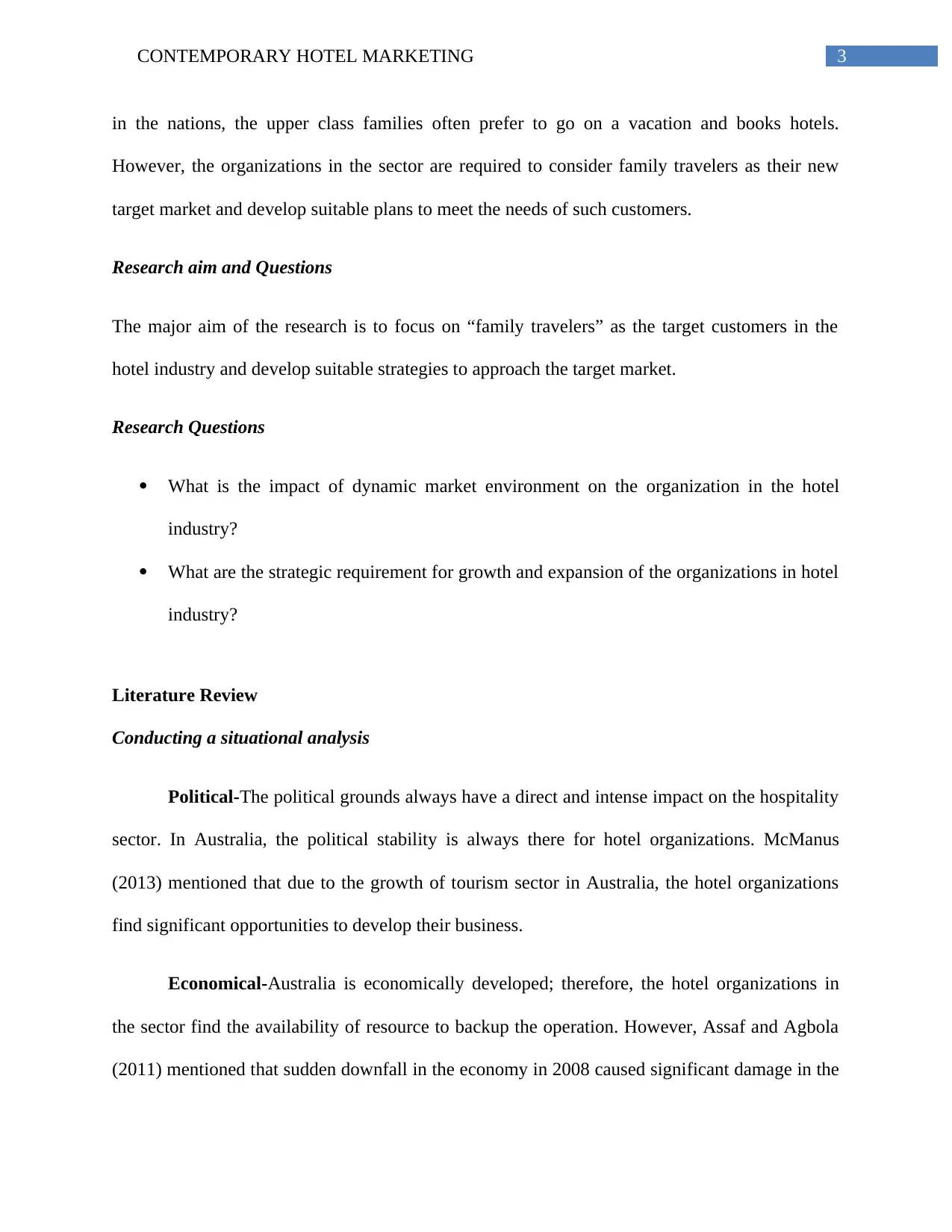
3CONTEMPORARY HOTEL MARKETING
in the nations, the upper class families often prefer to go on a vacation and books hotels.
However, the organizations in the sector are required to consider family travelers as their new
target market and develop suitable plans to meet the needs of such customers.
Research aim and Questions
The major aim of the research is to focus on “family travelers” as the target customers in the
hotel industry and develop suitable strategies to approach the target market.
Research Questions
What is the impact of dynamic market environment on the organization in the hotel
industry?
What are the strategic requirement for growth and expansion of the organizations in hotel
industry?
Literature Review
Conducting a situational analysis
Political-The political grounds always have a direct and intense impact on the hospitality
sector. In Australia, the political stability is always there for hotel organizations. McManus
(2013) mentioned that due to the growth of tourism sector in Australia, the hotel organizations
find significant opportunities to develop their business.
Economical-Australia is economically developed; therefore, the hotel organizations in
the sector find the availability of resource to backup the operation. However, Assaf and Agbola
(2011) mentioned that sudden downfall in the economy in 2008 caused significant damage in the
in the nations, the upper class families often prefer to go on a vacation and books hotels.
However, the organizations in the sector are required to consider family travelers as their new
target market and develop suitable plans to meet the needs of such customers.
Research aim and Questions
The major aim of the research is to focus on “family travelers” as the target customers in the
hotel industry and develop suitable strategies to approach the target market.
Research Questions
What is the impact of dynamic market environment on the organization in the hotel
industry?
What are the strategic requirement for growth and expansion of the organizations in hotel
industry?
Literature Review
Conducting a situational analysis
Political-The political grounds always have a direct and intense impact on the hospitality
sector. In Australia, the political stability is always there for hotel organizations. McManus
(2013) mentioned that due to the growth of tourism sector in Australia, the hotel organizations
find significant opportunities to develop their business.
Economical-Australia is economically developed; therefore, the hotel organizations in
the sector find the availability of resource to backup the operation. However, Assaf and Agbola
(2011) mentioned that sudden downfall in the economy in 2008 caused significant damage in the
Paraphrase This Document
Need a fresh take? Get an instant paraphrase of this document with our AI Paraphraser
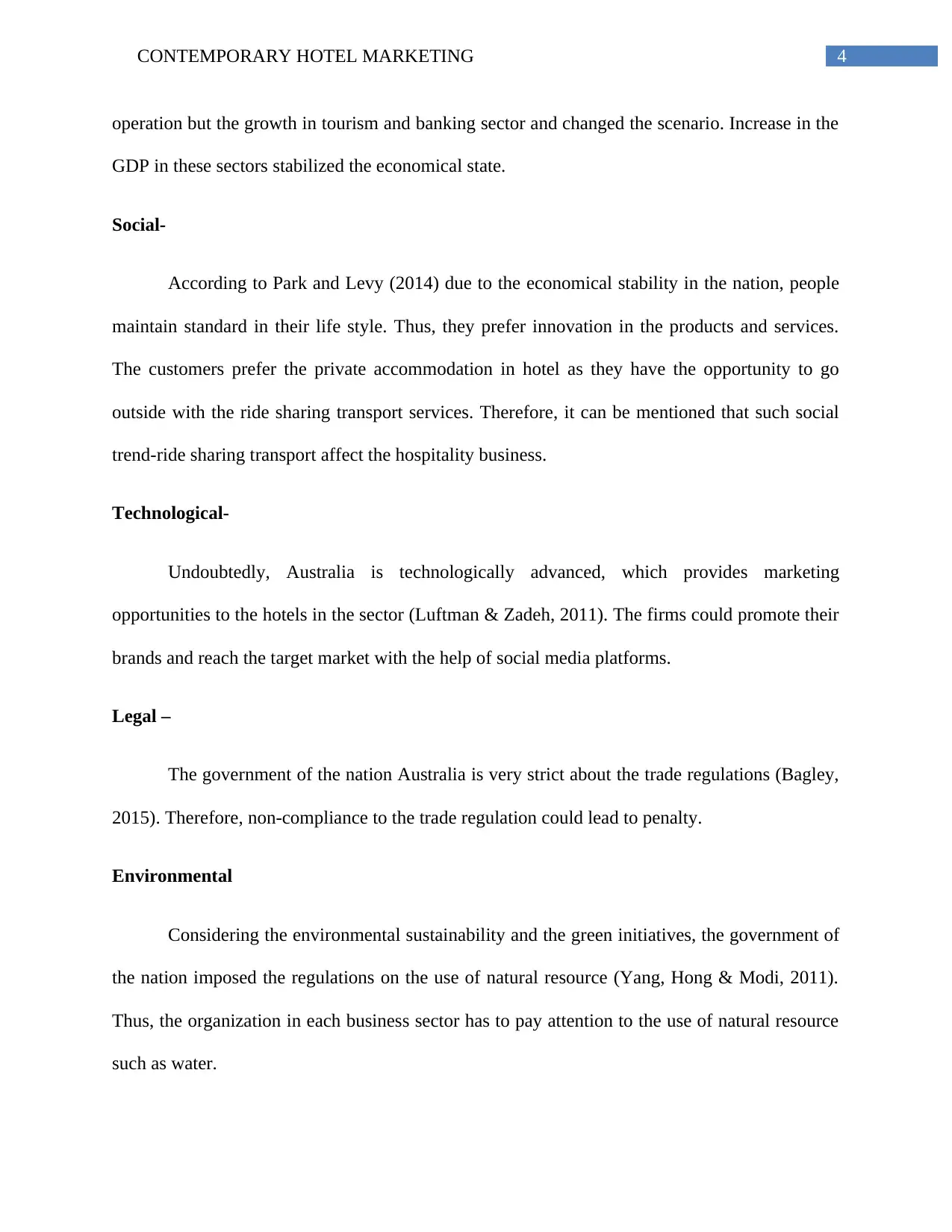
4CONTEMPORARY HOTEL MARKETING
operation but the growth in tourism and banking sector and changed the scenario. Increase in the
GDP in these sectors stabilized the economical state.
Social-
According to Park and Levy (2014) due to the economical stability in the nation, people
maintain standard in their life style. Thus, they prefer innovation in the products and services.
The customers prefer the private accommodation in hotel as they have the opportunity to go
outside with the ride sharing transport services. Therefore, it can be mentioned that such social
trend-ride sharing transport affect the hospitality business.
Technological-
Undoubtedly, Australia is technologically advanced, which provides marketing
opportunities to the hotels in the sector (Luftman & Zadeh, 2011). The firms could promote their
brands and reach the target market with the help of social media platforms.
Legal –
The government of the nation Australia is very strict about the trade regulations (Bagley,
2015). Therefore, non-compliance to the trade regulation could lead to penalty.
Environmental
Considering the environmental sustainability and the green initiatives, the government of
the nation imposed the regulations on the use of natural resource (Yang, Hong & Modi, 2011).
Thus, the organization in each business sector has to pay attention to the use of natural resource
such as water.
operation but the growth in tourism and banking sector and changed the scenario. Increase in the
GDP in these sectors stabilized the economical state.
Social-
According to Park and Levy (2014) due to the economical stability in the nation, people
maintain standard in their life style. Thus, they prefer innovation in the products and services.
The customers prefer the private accommodation in hotel as they have the opportunity to go
outside with the ride sharing transport services. Therefore, it can be mentioned that such social
trend-ride sharing transport affect the hospitality business.
Technological-
Undoubtedly, Australia is technologically advanced, which provides marketing
opportunities to the hotels in the sector (Luftman & Zadeh, 2011). The firms could promote their
brands and reach the target market with the help of social media platforms.
Legal –
The government of the nation Australia is very strict about the trade regulations (Bagley,
2015). Therefore, non-compliance to the trade regulation could lead to penalty.
Environmental
Considering the environmental sustainability and the green initiatives, the government of
the nation imposed the regulations on the use of natural resource (Yang, Hong & Modi, 2011).
Thus, the organization in each business sector has to pay attention to the use of natural resource
such as water.
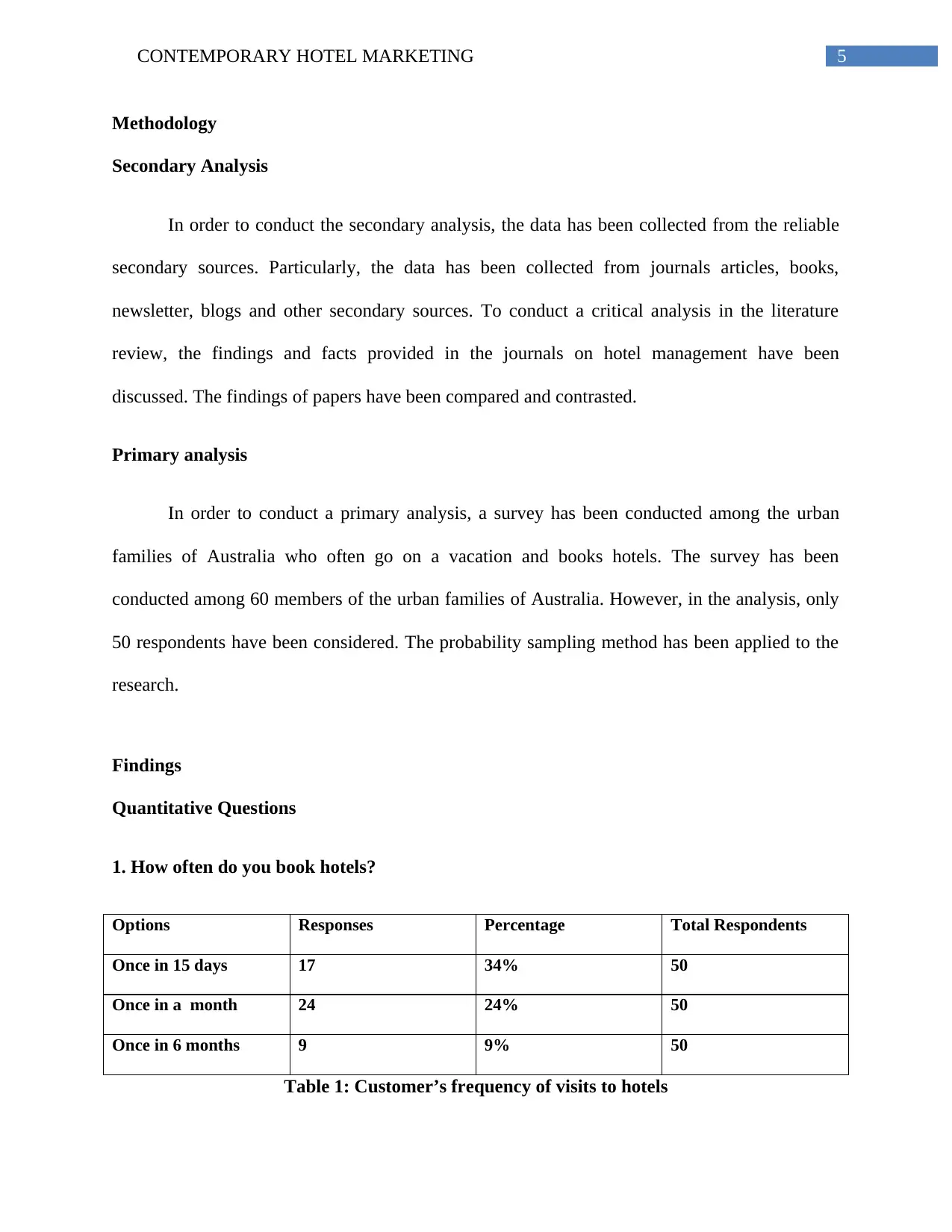
5CONTEMPORARY HOTEL MARKETING
Methodology
Secondary Analysis
In order to conduct the secondary analysis, the data has been collected from the reliable
secondary sources. Particularly, the data has been collected from journals articles, books,
newsletter, blogs and other secondary sources. To conduct a critical analysis in the literature
review, the findings and facts provided in the journals on hotel management have been
discussed. The findings of papers have been compared and contrasted.
Primary analysis
In order to conduct a primary analysis, a survey has been conducted among the urban
families of Australia who often go on a vacation and books hotels. The survey has been
conducted among 60 members of the urban families of Australia. However, in the analysis, only
50 respondents have been considered. The probability sampling method has been applied to the
research.
Findings
Quantitative Questions
1. How often do you book hotels?
Options Responses Percentage Total Respondents
Once in 15 days 17 34% 50
Once in a month 24 24% 50
Once in 6 months 9 9% 50
Table 1: Customer’s frequency of visits to hotels
Methodology
Secondary Analysis
In order to conduct the secondary analysis, the data has been collected from the reliable
secondary sources. Particularly, the data has been collected from journals articles, books,
newsletter, blogs and other secondary sources. To conduct a critical analysis in the literature
review, the findings and facts provided in the journals on hotel management have been
discussed. The findings of papers have been compared and contrasted.
Primary analysis
In order to conduct a primary analysis, a survey has been conducted among the urban
families of Australia who often go on a vacation and books hotels. The survey has been
conducted among 60 members of the urban families of Australia. However, in the analysis, only
50 respondents have been considered. The probability sampling method has been applied to the
research.
Findings
Quantitative Questions
1. How often do you book hotels?
Options Responses Percentage Total Respondents
Once in 15 days 17 34% 50
Once in a month 24 24% 50
Once in 6 months 9 9% 50
Table 1: Customer’s frequency of visits to hotels
⊘ This is a preview!⊘
Do you want full access?
Subscribe today to unlock all pages.

Trusted by 1+ million students worldwide
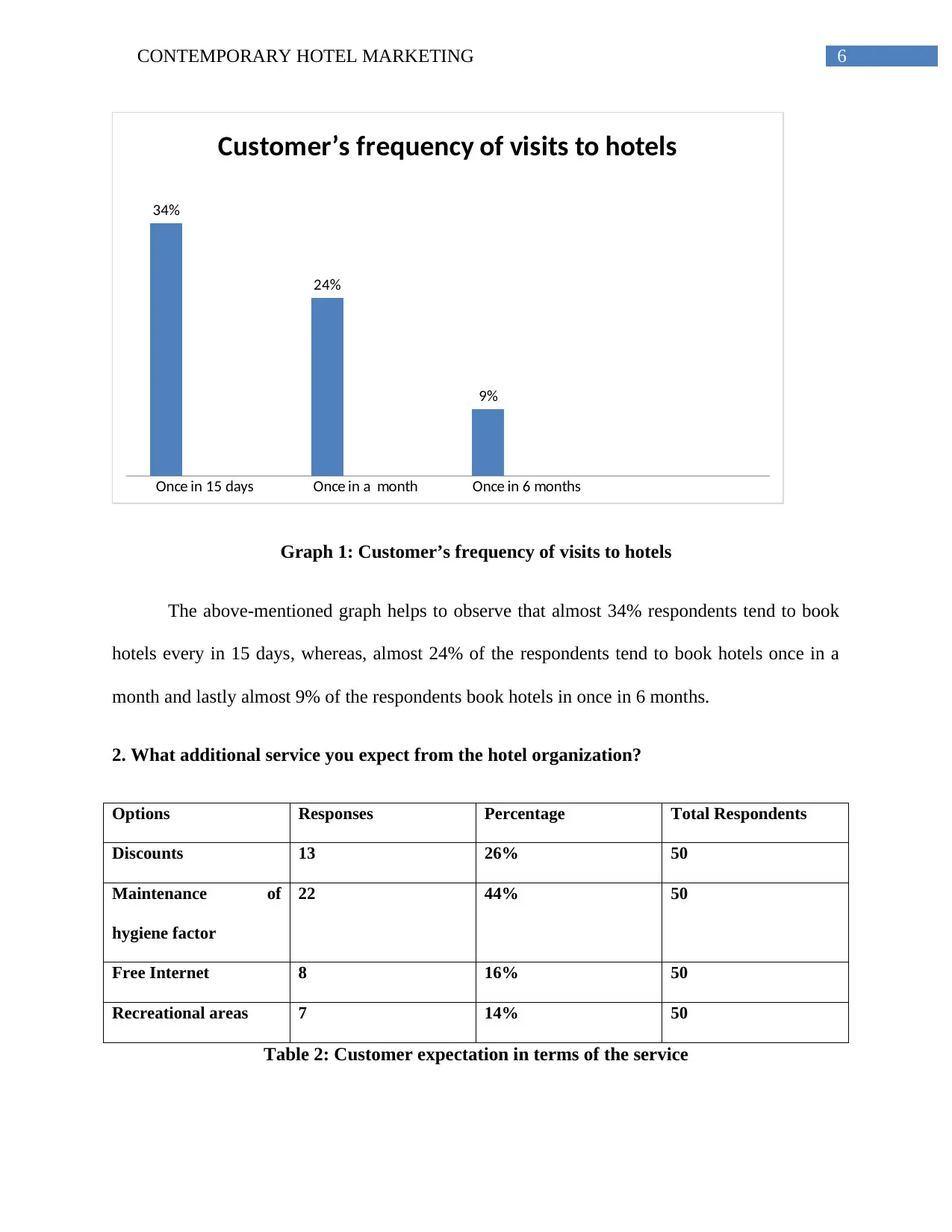
6CONTEMPORARY HOTEL MARKETING
Once in 15 days Once in a month Once in 6 months
34%
24%
9%
Customer’s frequency of visits to hotels
Graph 1: Customer’s frequency of visits to hotels
The above-mentioned graph helps to observe that almost 34% respondents tend to book
hotels every in 15 days, whereas, almost 24% of the respondents tend to book hotels once in a
month and lastly almost 9% of the respondents book hotels in once in 6 months.
2. What additional service you expect from the hotel organization?
Options Responses Percentage Total Respondents
Discounts 13 26% 50
Maintenance of
hygiene factor
22 44% 50
Free Internet 8 16% 50
Recreational areas 7 14% 50
Table 2: Customer expectation in terms of the service
Once in 15 days Once in a month Once in 6 months
34%
24%
9%
Customer’s frequency of visits to hotels
Graph 1: Customer’s frequency of visits to hotels
The above-mentioned graph helps to observe that almost 34% respondents tend to book
hotels every in 15 days, whereas, almost 24% of the respondents tend to book hotels once in a
month and lastly almost 9% of the respondents book hotels in once in 6 months.
2. What additional service you expect from the hotel organization?
Options Responses Percentage Total Respondents
Discounts 13 26% 50
Maintenance of
hygiene factor
22 44% 50
Free Internet 8 16% 50
Recreational areas 7 14% 50
Table 2: Customer expectation in terms of the service
Paraphrase This Document
Need a fresh take? Get an instant paraphrase of this document with our AI Paraphraser
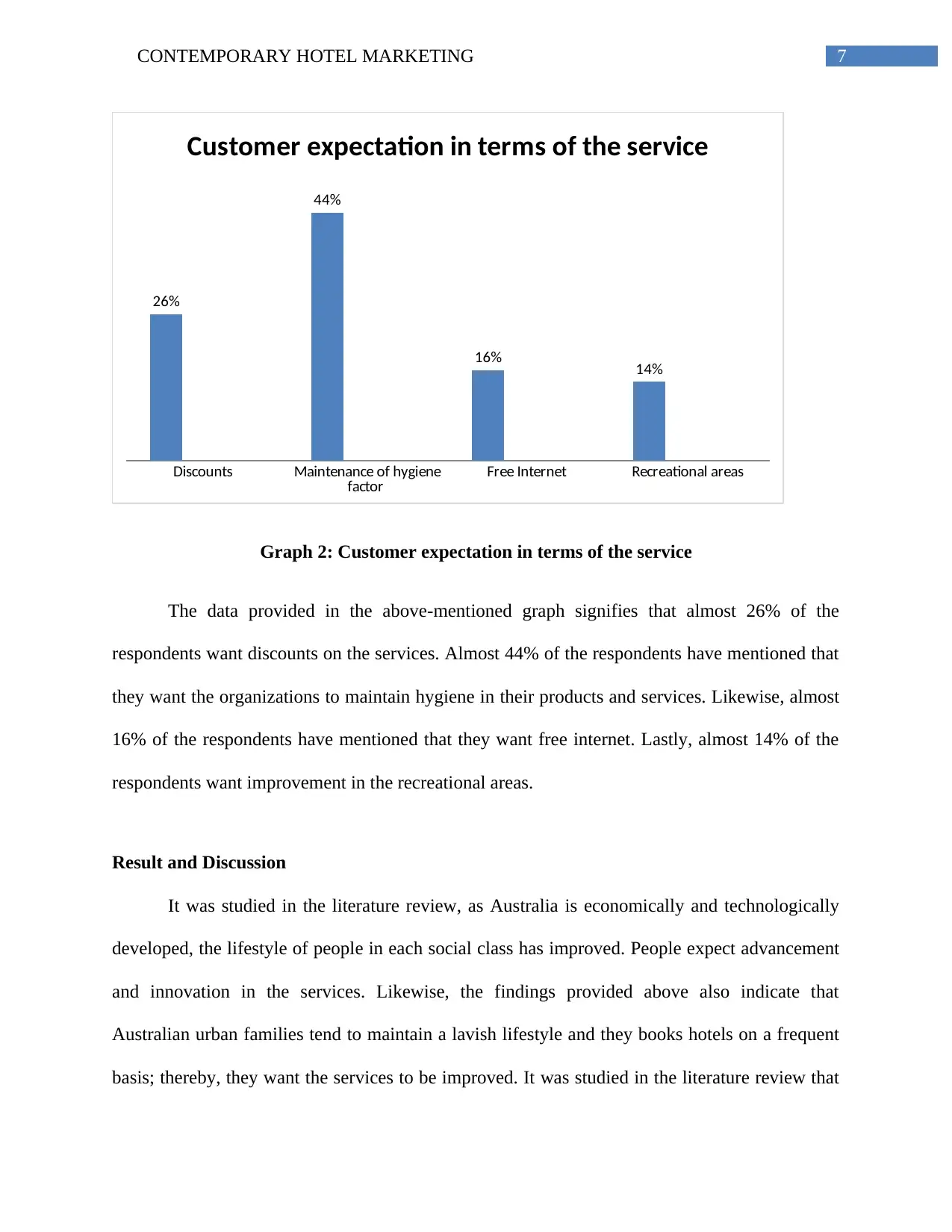
7CONTEMPORARY HOTEL MARKETING
Discounts Maintenance of hygiene
factor Free Internet Recreational areas
26%
44%
16% 14%
Customer expectation in terms of the service
Graph 2: Customer expectation in terms of the service
The data provided in the above-mentioned graph signifies that almost 26% of the
respondents want discounts on the services. Almost 44% of the respondents have mentioned that
they want the organizations to maintain hygiene in their products and services. Likewise, almost
16% of the respondents have mentioned that they want free internet. Lastly, almost 14% of the
respondents want improvement in the recreational areas.
Result and Discussion
It was studied in the literature review, as Australia is economically and technologically
developed, the lifestyle of people in each social class has improved. People expect advancement
and innovation in the services. Likewise, the findings provided above also indicate that
Australian urban families tend to maintain a lavish lifestyle and they books hotels on a frequent
basis; thereby, they want the services to be improved. It was studied in the literature review that
Discounts Maintenance of hygiene
factor Free Internet Recreational areas
26%
44%
16% 14%
Customer expectation in terms of the service
Graph 2: Customer expectation in terms of the service
The data provided in the above-mentioned graph signifies that almost 26% of the
respondents want discounts on the services. Almost 44% of the respondents have mentioned that
they want the organizations to maintain hygiene in their products and services. Likewise, almost
16% of the respondents have mentioned that they want free internet. Lastly, almost 14% of the
respondents want improvement in the recreational areas.
Result and Discussion
It was studied in the literature review, as Australia is economically and technologically
developed, the lifestyle of people in each social class has improved. People expect advancement
and innovation in the services. Likewise, the findings provided above also indicate that
Australian urban families tend to maintain a lavish lifestyle and they books hotels on a frequent
basis; thereby, they want the services to be improved. It was studied in the literature review that
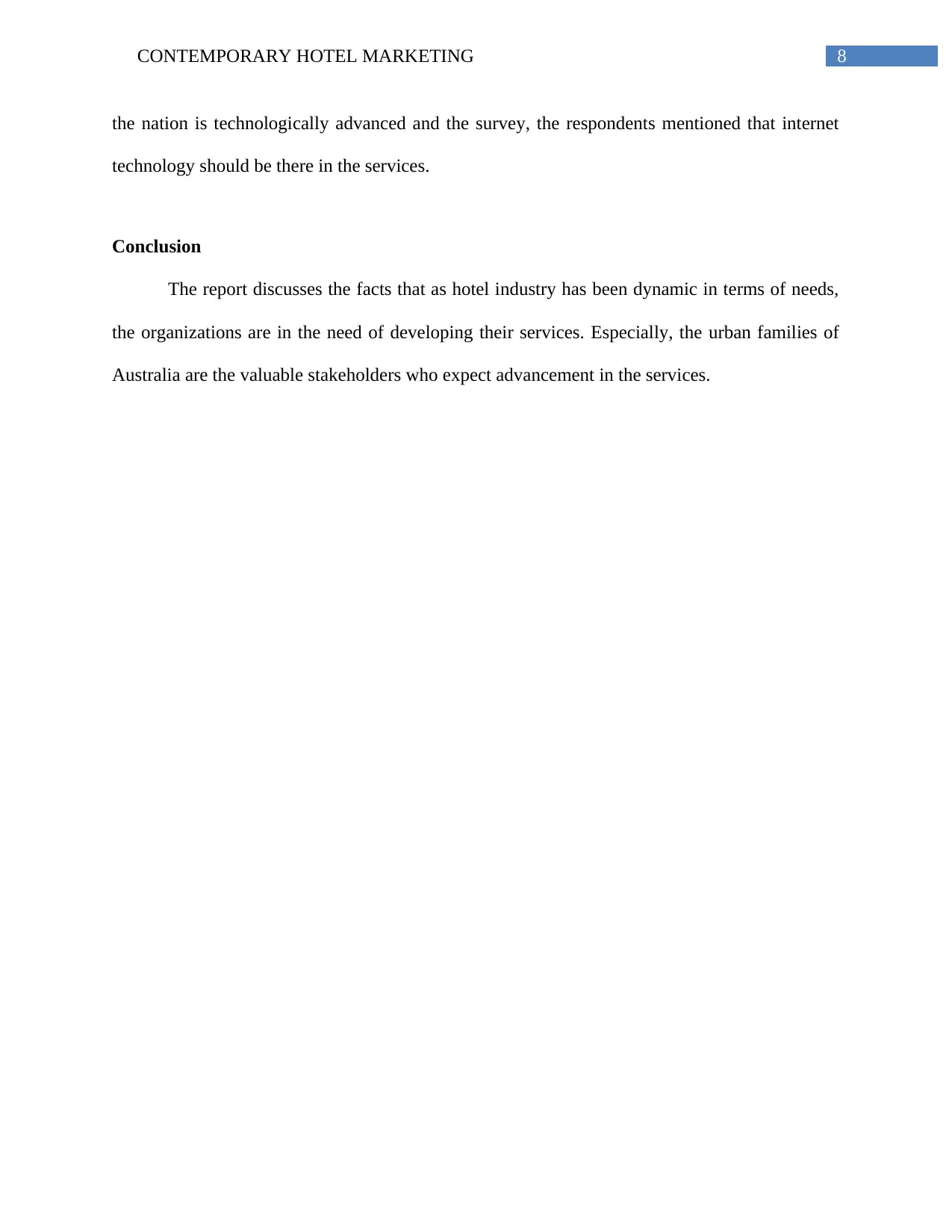
8CONTEMPORARY HOTEL MARKETING
the nation is technologically advanced and the survey, the respondents mentioned that internet
technology should be there in the services.
Conclusion
The report discusses the facts that as hotel industry has been dynamic in terms of needs,
the organizations are in the need of developing their services. Especially, the urban families of
Australia are the valuable stakeholders who expect advancement in the services.
the nation is technologically advanced and the survey, the respondents mentioned that internet
technology should be there in the services.
Conclusion
The report discusses the facts that as hotel industry has been dynamic in terms of needs,
the organizations are in the need of developing their services. Especially, the urban families of
Australia are the valuable stakeholders who expect advancement in the services.
⊘ This is a preview!⊘
Do you want full access?
Subscribe today to unlock all pages.

Trusted by 1+ million students worldwide
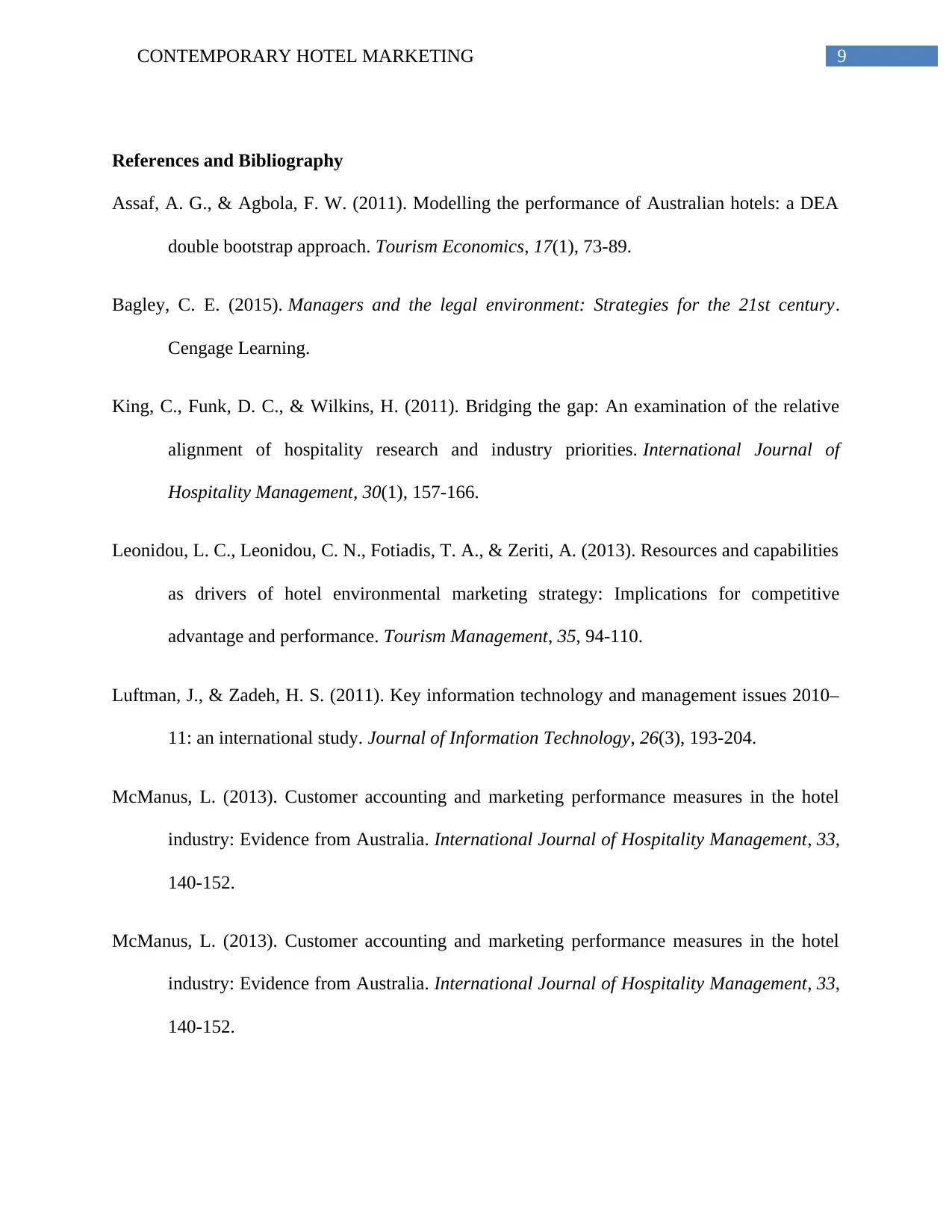
9CONTEMPORARY HOTEL MARKETING
References and Bibliography
Assaf, A. G., & Agbola, F. W. (2011). Modelling the performance of Australian hotels: a DEA
double bootstrap approach. Tourism Economics, 17(1), 73-89.
Bagley, C. E. (2015). Managers and the legal environment: Strategies for the 21st century.
Cengage Learning.
King, C., Funk, D. C., & Wilkins, H. (2011). Bridging the gap: An examination of the relative
alignment of hospitality research and industry priorities. International Journal of
Hospitality Management, 30(1), 157-166.
Leonidou, L. C., Leonidou, C. N., Fotiadis, T. A., & Zeriti, A. (2013). Resources and capabilities
as drivers of hotel environmental marketing strategy: Implications for competitive
advantage and performance. Tourism Management, 35, 94-110.
Luftman, J., & Zadeh, H. S. (2011). Key information technology and management issues 2010–
11: an international study. Journal of Information Technology, 26(3), 193-204.
McManus, L. (2013). Customer accounting and marketing performance measures in the hotel
industry: Evidence from Australia. International Journal of Hospitality Management, 33,
140-152.
McManus, L. (2013). Customer accounting and marketing performance measures in the hotel
industry: Evidence from Australia. International Journal of Hospitality Management, 33,
140-152.
References and Bibliography
Assaf, A. G., & Agbola, F. W. (2011). Modelling the performance of Australian hotels: a DEA
double bootstrap approach. Tourism Economics, 17(1), 73-89.
Bagley, C. E. (2015). Managers and the legal environment: Strategies for the 21st century.
Cengage Learning.
King, C., Funk, D. C., & Wilkins, H. (2011). Bridging the gap: An examination of the relative
alignment of hospitality research and industry priorities. International Journal of
Hospitality Management, 30(1), 157-166.
Leonidou, L. C., Leonidou, C. N., Fotiadis, T. A., & Zeriti, A. (2013). Resources and capabilities
as drivers of hotel environmental marketing strategy: Implications for competitive
advantage and performance. Tourism Management, 35, 94-110.
Luftman, J., & Zadeh, H. S. (2011). Key information technology and management issues 2010–
11: an international study. Journal of Information Technology, 26(3), 193-204.
McManus, L. (2013). Customer accounting and marketing performance measures in the hotel
industry: Evidence from Australia. International Journal of Hospitality Management, 33,
140-152.
McManus, L. (2013). Customer accounting and marketing performance measures in the hotel
industry: Evidence from Australia. International Journal of Hospitality Management, 33,
140-152.
Paraphrase This Document
Need a fresh take? Get an instant paraphrase of this document with our AI Paraphraser
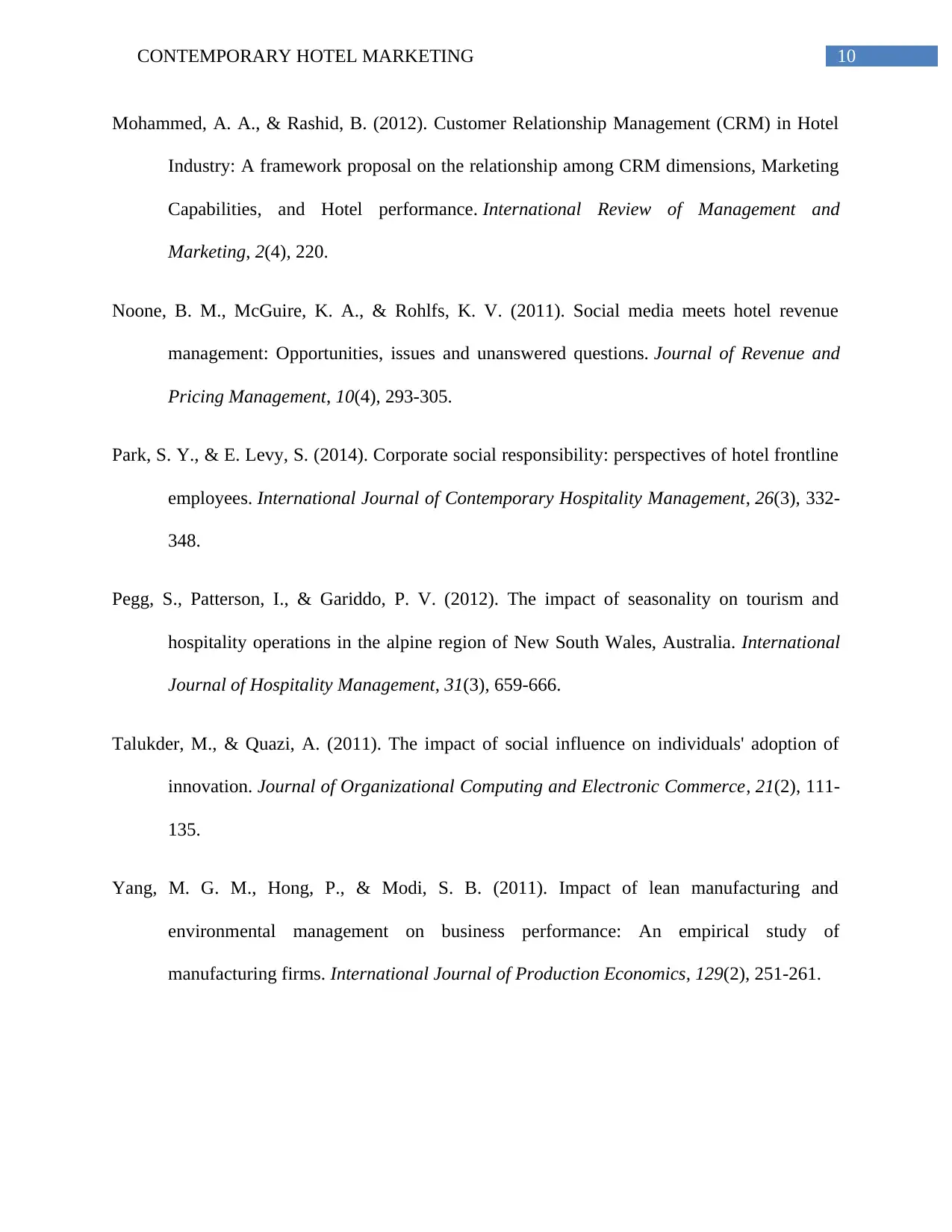
10CONTEMPORARY HOTEL MARKETING
Mohammed, A. A., & Rashid, B. (2012). Customer Relationship Management (CRM) in Hotel
Industry: A framework proposal on the relationship among CRM dimensions, Marketing
Capabilities, and Hotel performance. International Review of Management and
Marketing, 2(4), 220.
Noone, B. M., McGuire, K. A., & Rohlfs, K. V. (2011). Social media meets hotel revenue
management: Opportunities, issues and unanswered questions. Journal of Revenue and
Pricing Management, 10(4), 293-305.
Park, S. Y., & E. Levy, S. (2014). Corporate social responsibility: perspectives of hotel frontline
employees. International Journal of Contemporary Hospitality Management, 26(3), 332-
348.
Pegg, S., Patterson, I., & Gariddo, P. V. (2012). The impact of seasonality on tourism and
hospitality operations in the alpine region of New South Wales, Australia. International
Journal of Hospitality Management, 31(3), 659-666.
Talukder, M., & Quazi, A. (2011). The impact of social influence on individuals' adoption of
innovation. Journal of Organizational Computing and Electronic Commerce, 21(2), 111-
135.
Yang, M. G. M., Hong, P., & Modi, S. B. (2011). Impact of lean manufacturing and
environmental management on business performance: An empirical study of
manufacturing firms. International Journal of Production Economics, 129(2), 251-261.
Mohammed, A. A., & Rashid, B. (2012). Customer Relationship Management (CRM) in Hotel
Industry: A framework proposal on the relationship among CRM dimensions, Marketing
Capabilities, and Hotel performance. International Review of Management and
Marketing, 2(4), 220.
Noone, B. M., McGuire, K. A., & Rohlfs, K. V. (2011). Social media meets hotel revenue
management: Opportunities, issues and unanswered questions. Journal of Revenue and
Pricing Management, 10(4), 293-305.
Park, S. Y., & E. Levy, S. (2014). Corporate social responsibility: perspectives of hotel frontline
employees. International Journal of Contemporary Hospitality Management, 26(3), 332-
348.
Pegg, S., Patterson, I., & Gariddo, P. V. (2012). The impact of seasonality on tourism and
hospitality operations in the alpine region of New South Wales, Australia. International
Journal of Hospitality Management, 31(3), 659-666.
Talukder, M., & Quazi, A. (2011). The impact of social influence on individuals' adoption of
innovation. Journal of Organizational Computing and Electronic Commerce, 21(2), 111-
135.
Yang, M. G. M., Hong, P., & Modi, S. B. (2011). Impact of lean manufacturing and
environmental management on business performance: An empirical study of
manufacturing firms. International Journal of Production Economics, 129(2), 251-261.
1 out of 11
Related Documents
Your All-in-One AI-Powered Toolkit for Academic Success.
+13062052269
info@desklib.com
Available 24*7 on WhatsApp / Email
![[object Object]](/_next/static/media/star-bottom.7253800d.svg)
Unlock your academic potential
Copyright © 2020–2025 A2Z Services. All Rights Reserved. Developed and managed by ZUCOL.





